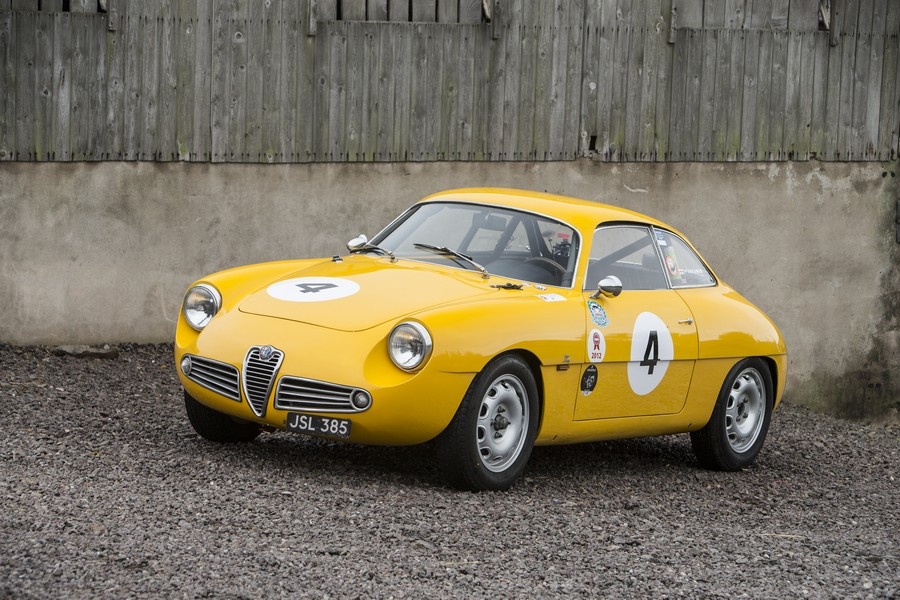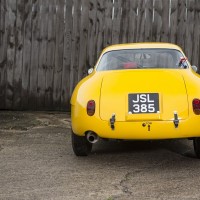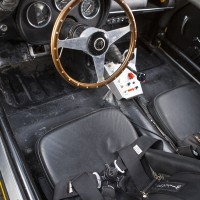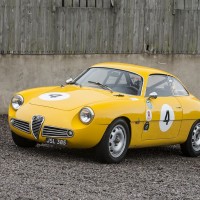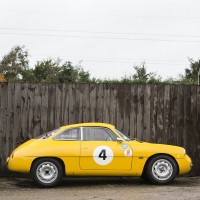Alfa Romeo’s successful Giulietta range debuted in 1954 with the arrival of the Bertone-styled Sprint coupe, the Berlina (saloon) not appearing until the succeeding season. Veloce models with improved performance followed, and the agile Giulietta SV quickly established an enviable record in production-car racing, notable victories including a Gran Turismo class win in the 1956 Mille Miglia. Nevertheless, to fully exploit the car’s potential, lighter and more aerodynamic bodywork was deemed necessary — a requirement which resulted in the ultimate Giuliettas: Bertone’s Sprint Special and the Sprint Zagato (SZ), both built on the short-wheelbase Spider platform and powered by the 116-hp version of Alfa’s classic 1.3-liter, twin-cam, 4-cylinder engine.
Conceived as an out-and-out competition car, the Sprint Zagato coupe adopted lightweight aluminum-alloy coachwork and demonstrated its designer’s commitment to weight saving in every detail, tipping the scales at an astonishing 785 kg (1,730 pounds). With a top speed of around 125 mph, the SZ was easily the fastest of the Giuliettas, and even today there are few 1.3-liter cars capable of matching this level of performance. The SZ’s inherent stability and instantaneous response to steering input made it a driver’s car par excellence. On the racetrack it proved virtually unbeatable, and the Sprint Zagato remains a major force to be reckoned with in historic motorsport, being eligible for a wide variety of the most prestigious events, including the Le Mans Classic.
SCM Analysis
Detailing
| Vehicle: | 1961 Alfa Romeo SZ-1 Coupe |
| Number Produced: | 200 (170 SZ-1, 30 SZ-2) |
| Original List Price: | $5,000 |
| Chassis Number Location: | On firewall in engine compartment |
| Engine Number Location: | Right side of block |
| Club Info: | SZ Register |
| Website: | http://www.szregister.com |
| Investment Grade: | A |
This car, Lot 28, sold for $442,924, including buyer’s premium, at Bonhams’ December Sale in London on December 1, 2013.
I’m going to put this right out front: I’m an Alfa guy.
I kept a very worn-out Jag XK 150 alive through undergraduate school while quietly lusting after several friends’ Giulietta Sprints and their lithe sophistication. Although I had the legs on the straights, as soon as the roads got twisty or snowy (it was Colorado), the Alfas were gone.
When I graduated, I bought a new 1967 GTV, and, with the exception of a brief liaison with a BMW 530i, drove only Alfas until well after they stopped importing them. I still have that ’67 GTV I bought way back then — now freshly restored. I am thus either highly qualified or woefully too prejudiced to write about an Alfa SZ — maybe both.
A history of lithe performance
Although Alfa Romeo built everything from heavy trucks to delivery vans and sedans, it always saw itself as a performance — and particularly a racing car — company. Through the 1930s and 1940s it saw itself quite correctly as the de facto Italian National racing team. The spectacular 8C series of racers was extremely successful, and toward the end of the 1930s, these cars were the only ones that dared to stand against the Titan Cars of the Third Reich.
When the formula went to 1.5 liters supercharged, Alfa created the Alfetta, one of the most spectacular, knees-weak-beautiful racers ever built. After World War II, Alfa dusted off the Alfetta and dominated the early years of post-war GP racing. Money was getting tough, though, and after a final effort with the 3000CM of 1952–53, Alfa faced reality and shut down its competition department.
Sprinting back to the track
Racing and performance remained deeply ingrained in the culture and the blood of the company, so when the new Giulietta production series was announced in late 1954, it was not a staid sedan but the Bertone-designed Sprint — a 2+2 GT coupe — that was behind the curtain. Sedans, Spiders — and even a station wagon — would follow, but the car Alfa chose to define itself to the world was a sporting coupe.
Although Alfa was officially out of the racing business, its customers certainly weren’t, and Sprints were soon competing all over Europe. Alfa was, of course, happy to assist, and set about creating a higher-performance variant: the Sprint Veloce. It was introduced two years to the month after the original Sprint, having shed 70 kg (154 pounds) of weight and gone from 65 to 90 horsepower.
One of the first Sprint Veloces was entered in the 1956 Mille Miglia, where it rolled badly. Rather than send it back to Alfa for a new body, the owner decided to send it to Zagato for a lightweight aluminum body. Debuting in late 1956, the revised car was an immediate success and gained the semi-official designation of SVZ. It wasn’t an official factory effort, but it was not discouraged, and over the next few years roughly 18 SVZs ended up being created.
In the meantime, Alfa experimented with a very swoopy Bertone design based on the shorter Spider chassis with an even stronger motor: the Sprint Speciale. The Sprint Speciale was gorgeous, but it turned out to be 55 kg (121 pounds) heavier than the SV, so any thoughts of using it in competition vanished.
Alfa then went knocking on Zagato’s door with an eye toward creating an official version of what Zagato had been doing already. The Alfa Romeo Sprint Zagato was introduced in early 1960. The SZ sported the short chassis, 100-hp engine and 5-speed transmission of the Sprint Speciale — but it was hundreds of pounds lighter with almost no front or rear overhangs. The car was a very compact, highly competitive racer.
The important thing to remember is that it was still at heart a production Giulietta: the suspension, drivetrain, brakes and even the engine were production stuff.
A grocery-getter and serious racer
This means the SZ (at least as it came from the factory) was not a fire-breathing racing car; it was a very lightweight, short Giulietta Sprint. From a practical standpoint this meant that, like its big cousin the Ferrari SWB, it was a tractable everyday driver that could comfortably take your wife on a jaunt down the coast or to the grocery store as easily as it could seriously compete on the track.
For a collector in today’s world, this can be a distinct advantage. Alfa’s successor TZ — fabulous cars that they are — are lousy street or tour cars, as they’re really only happy on the track. SZs are truly fabulous drivers. They don’t have a lot of horsepower, but they are wonderfully balanced, neutral and forgiving. For a romp through the Dolomites or the California Mille (which is notoriously run on the most twisty roads Northern California can offer), I can think of no more pleasurable car at any price.
Rising for 20 years
All this, of course, brings us to the question of value. For most of the past 40 years — and certainly well into the late 1990s — post-war Alfas of any sort just didn’t carry much market value. It is interesting to note, though, that their relative values have remained very stable.
In 1994, my company traded a pretty good Ferrari 275 GTB/4 for a package of excellent Zagato Alfas. We set the value at $325,000 for the 4-cam, and got a TZ for $150,000, an SZ II (Kamm tail) for $90,000, and an SZ for $85,000 in exchange (yeah, to know then what we know now).
The point to note is that the SZs were valued at roughly half of the TZ. We sold the TZ and the SZ immediately, but the SZ II went to a friend and stayed with us. He sold it (painted Alfa Red) for $250,000 in 2008 to another friend who brought it back to its 1963 Le Mans livery (it was a great car, dripping history, as it turned out) and sold it to Europe for $440,000 in 2010. Although it is emphatically not for sale, I am told it is worth about $800,000 now. Interestingly, a good Alfa TZ is now worth about $1.5 million, so the “about half” ratio has held constant over all these years.
Those values are for the best cars, however, and today’s subject car is far from the best. As I have often pontificated, market value is a combination of collector and user considerations.
As fabulous tour drivers with often-great histories, Alfa SZs carry value based on their provenance, as well as their usefulness as a tour and event car, and as a track racer. Our subject today appears to have no significant period history and has been turned into a single-purpose track toy (130 horsepower at 9,000 rpm is strictly for the track), so its value is appropriately limited. With the racing specifications listed in the catalog, I’m sure this car is a wonderful racer, but that is all it is. As such, I’d say fairly bought and sold. ♦
(Introductory description courtesy of Bonhams.)
